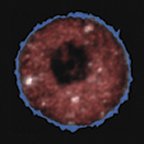Detecting cancer in a flash
From Los Angeles, at a meeting of the American Physical Society


Even at the cellular level, there’s a special glow to good health. That’s the conclusion of a research team that has demonstrated the ability to distinguish cancer cells from healthy ones with pulses of laser light.
To achieve that discrimination, physicist Paul L. Gourley of Sandia National Laboratories in Albuquerque, and his colleagues used a novel microchip laser of their own invention. The laser features an opening through which fluids, including slurries of biological cells, can flow. As each cell passes through this so-called biocavity laser, it temporarily acts as a lens for the device, stimulating a burst of laser light.
In earlier work, the team found that organelles called mitochondria within a cell strongly affect colors and other characteristics of the outgoing pulses. In normal cells, mitochondria are shaped like tiny beans and generate the power that cells need (SN: 3/5/05, p. 158: Available to subscribers at Cytoplasm affects embryonic development).
Now the researchers report that cancer cells yield pulses with tints and other optical traits that are detectably different from those of healthy cells. The scientists attribute the differences to changes in mitochondria that occur when a cell becomes cancerous. “The mitochondria in this [cancer] cell are sitting as little balled-up creatures,” so they influence light differently, Gourley says.
To determine whether tissue is cancerous, oncologists now have to take biopsies of tissues and subject them to various laboratory tests—a process that can take days or more. “We’re trying to eliminate all those steps,” says Gourley.
He and his colleagues have already tested their method on human and animal tissues, including liver, brain, lung, and muscle samples. The method now requires thousands of cells to reveal cancerous tissue. But the researchers claim it has the potential to identify cancer in a single cell by means of a single light pulse.
Ultimately, Gourley says, physicians equipped with surgical tools incorporating the microlaser may immediately identify cancerous cells and treat the disease in the same procedure.







